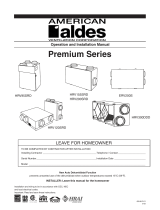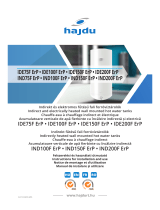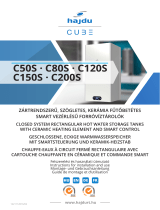Aldes ZRT-1 Zone Register Terminal Ventilation System Owner's manual
- Type
- Owner's manual
Aldes ZRT-1 Zone Register Terminal Ventilation System:
The Aldes ZRT-1 Zone Register Terminal Ventilation System is a patented ventilation system designed to introduce flexibility and dynamic control to central ventilation systems. The ZRT-1 is a combination grille, register box, control damper, and optional flow regulator(s). This unique combination provides up to four different control schemes without the need for expensive pneumatic, electronic, or DDC control systems.
The ZRT-1 can be used in both large and small systems, and can be ordered in a supply or exhaust ventilation configuration. By replacing static grilles in large central systems, the ZRT-1 provides on-off control for on-demand ventilation. This allows central fan downsizing and promotes energy savings by minimizing necessary fan horsepower and ventilation-induced heat and cooling loads on the building.
Aldes ZRT-1 Zone Register Terminal Ventilation System:
The Aldes ZRT-1 Zone Register Terminal Ventilation System is a patented ventilation system designed to introduce flexibility and dynamic control to central ventilation systems. The ZRT-1 is a combination grille, register box, control damper, and optional flow regulator(s). This unique combination provides up to four different control schemes without the need for expensive pneumatic, electronic, or DDC control systems.
The ZRT-1 can be used in both large and small systems, and can be ordered in a supply or exhaust ventilation configuration. By replacing static grilles in large central systems, the ZRT-1 provides on-off control for on-demand ventilation. This allows central fan downsizing and promotes energy savings by minimizing necessary fan horsepower and ventilation-induced heat and cooling loads on the building.




-
 1
1
-
 2
2
-
 3
3
-
 4
4
Aldes ZRT-1 Zone Register Terminal Ventilation System Owner's manual
- Type
- Owner's manual
Aldes ZRT-1 Zone Register Terminal Ventilation System:
The Aldes ZRT-1 Zone Register Terminal Ventilation System is a patented ventilation system designed to introduce flexibility and dynamic control to central ventilation systems. The ZRT-1 is a combination grille, register box, control damper, and optional flow regulator(s). This unique combination provides up to four different control schemes without the need for expensive pneumatic, electronic, or DDC control systems.
The ZRT-1 can be used in both large and small systems, and can be ordered in a supply or exhaust ventilation configuration. By replacing static grilles in large central systems, the ZRT-1 provides on-off control for on-demand ventilation. This allows central fan downsizing and promotes energy savings by minimizing necessary fan horsepower and ventilation-induced heat and cooling loads on the building.
Ask a question and I''ll find the answer in the document
Finding information in a document is now easier with AI
Related papers
Other documents
-
Alde ZRT Zone Register Terminal Airflow and Zone Control User manual
-
 American Aldes Premium HRV300DDD Operation and Installation Manual
American Aldes Premium HRV300DDD Operation and Installation Manual
-
 hajdu Z300S ErP Installation And Usage Instructions
hajdu Z300S ErP Installation And Usage Instructions
-
 hajdu IDE75F ErP Instructions For Installation And Use Manual
hajdu IDE75F ErP Instructions For Installation And Use Manual
-
Zanussi ZRT623W User manual
-
Komfovent SCD and SQD sensor User manual
-
Dometic DS301H, DS601H (Type: DSH20-60) Operating instructions
-
Wellis Discovery User manual
-
 hajdu CUBE C80S Instructions For Installation And Use Manual
hajdu CUBE C80S Instructions For Installation And Use Manual
-
Dometic EA3100 User manual







